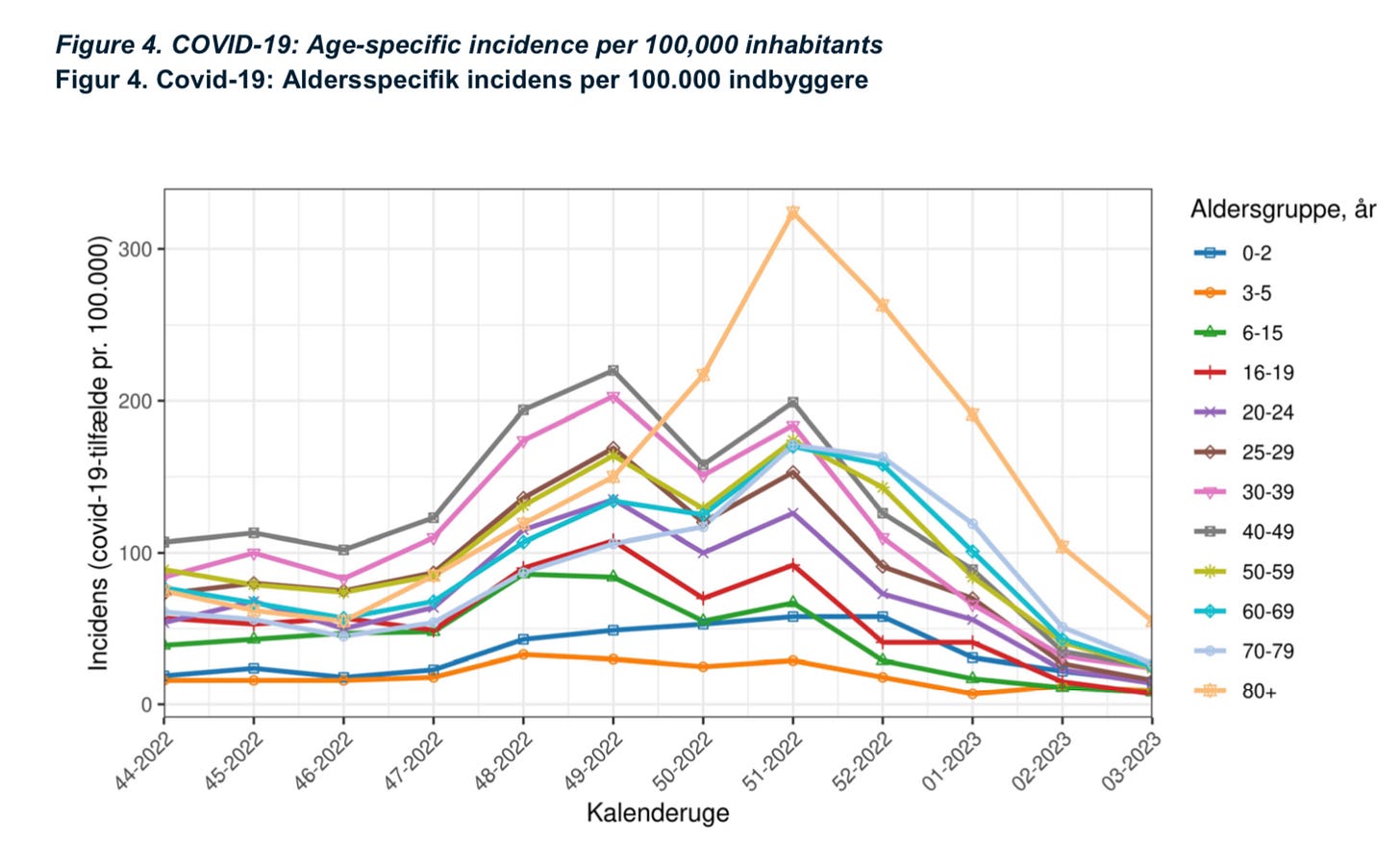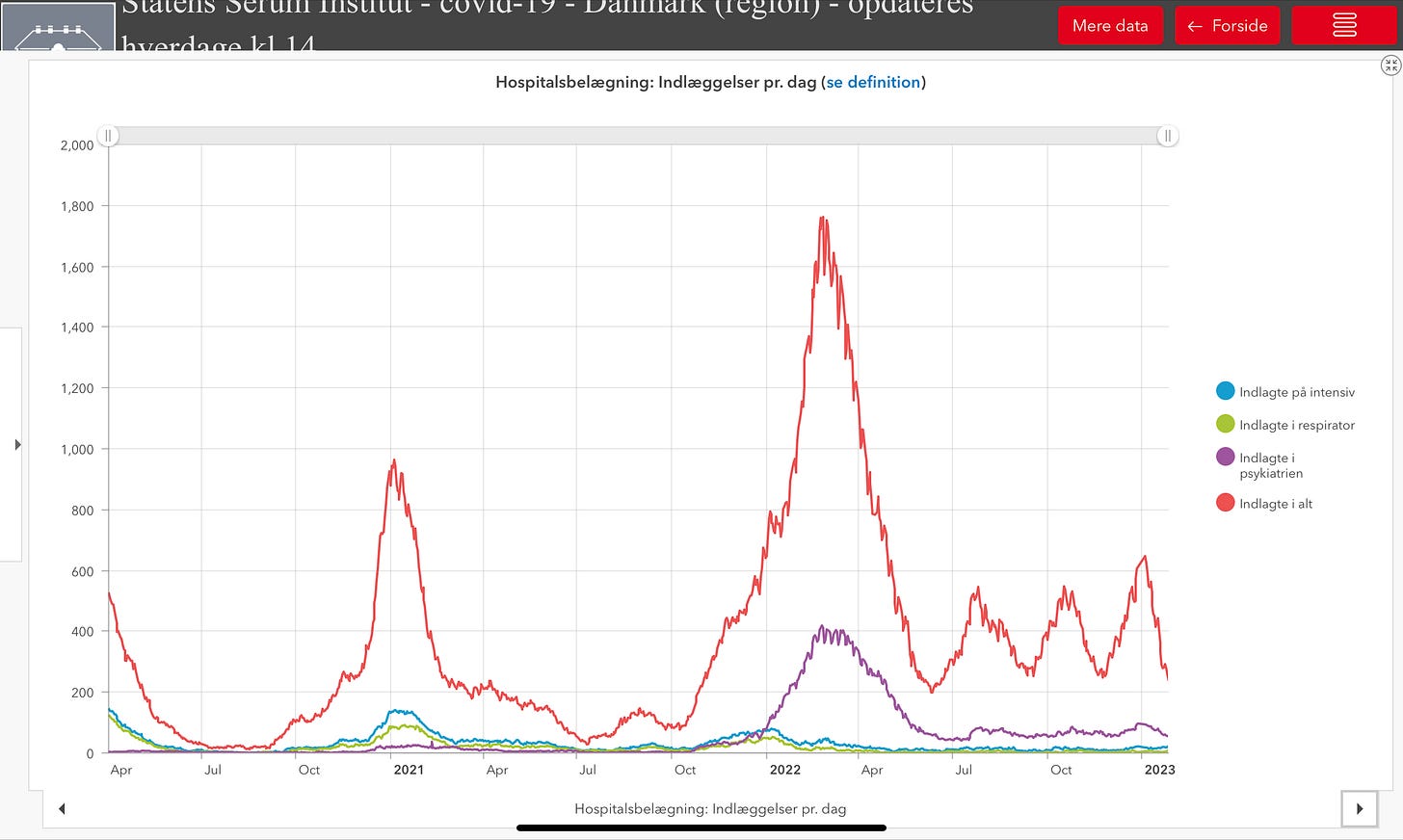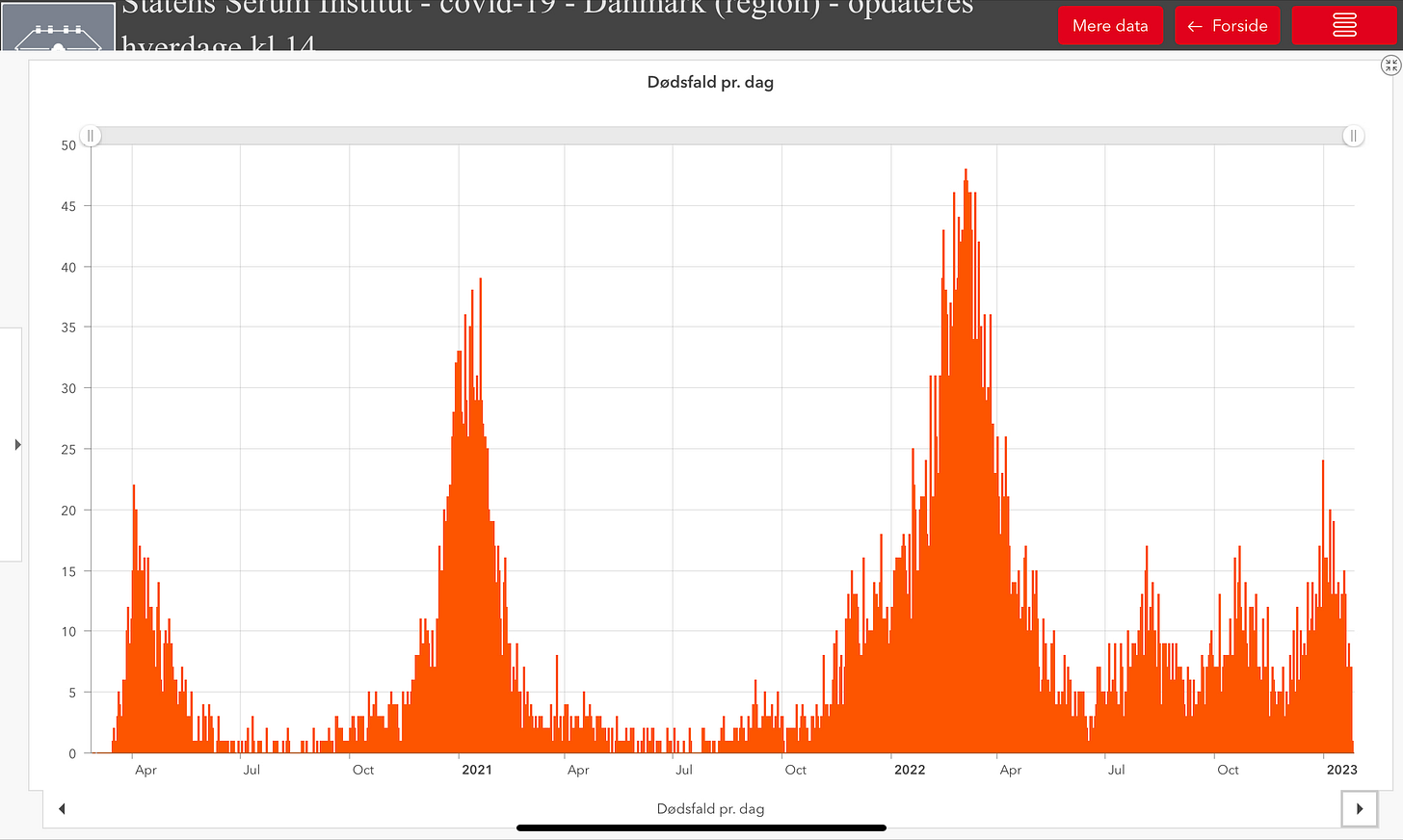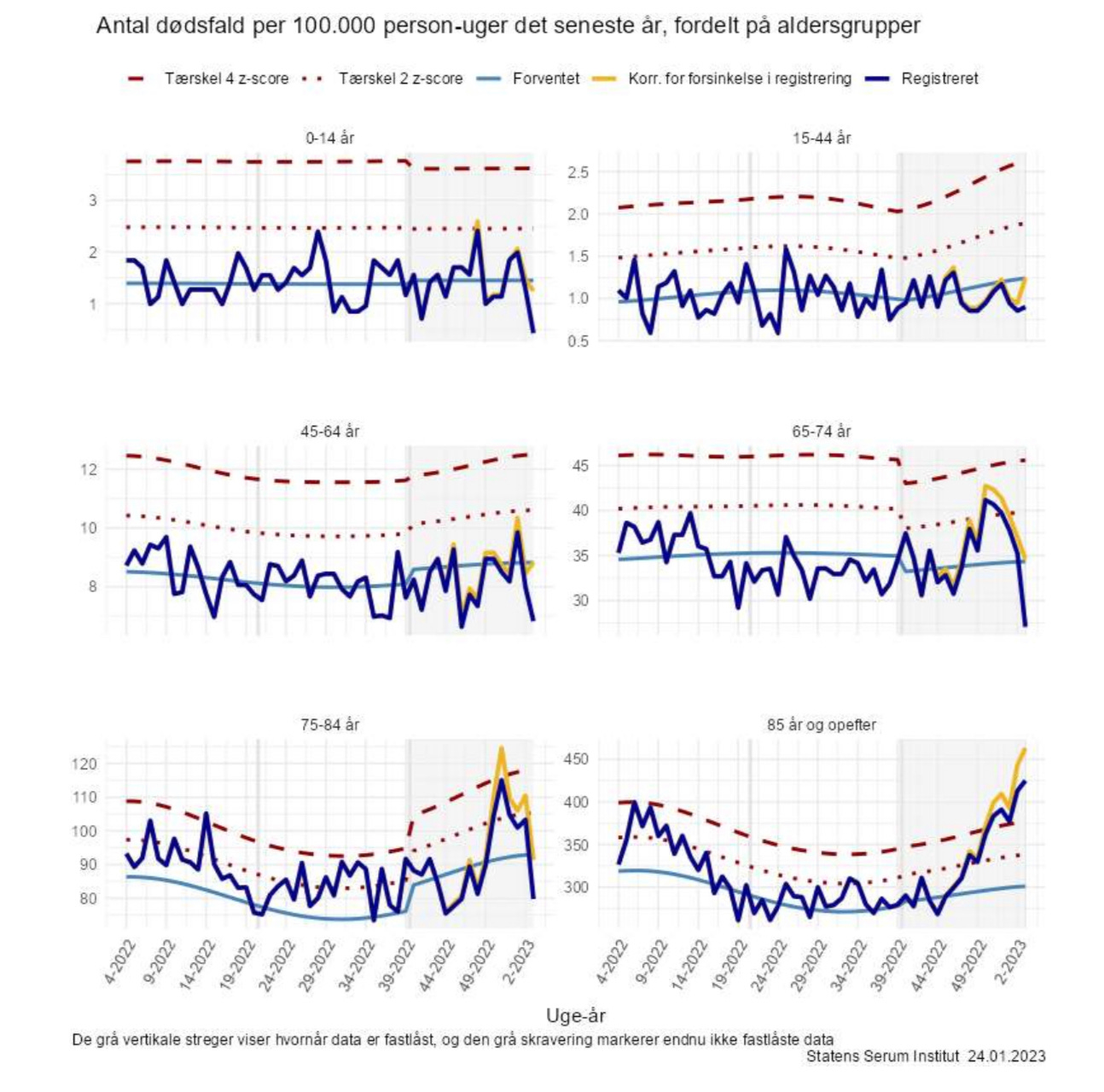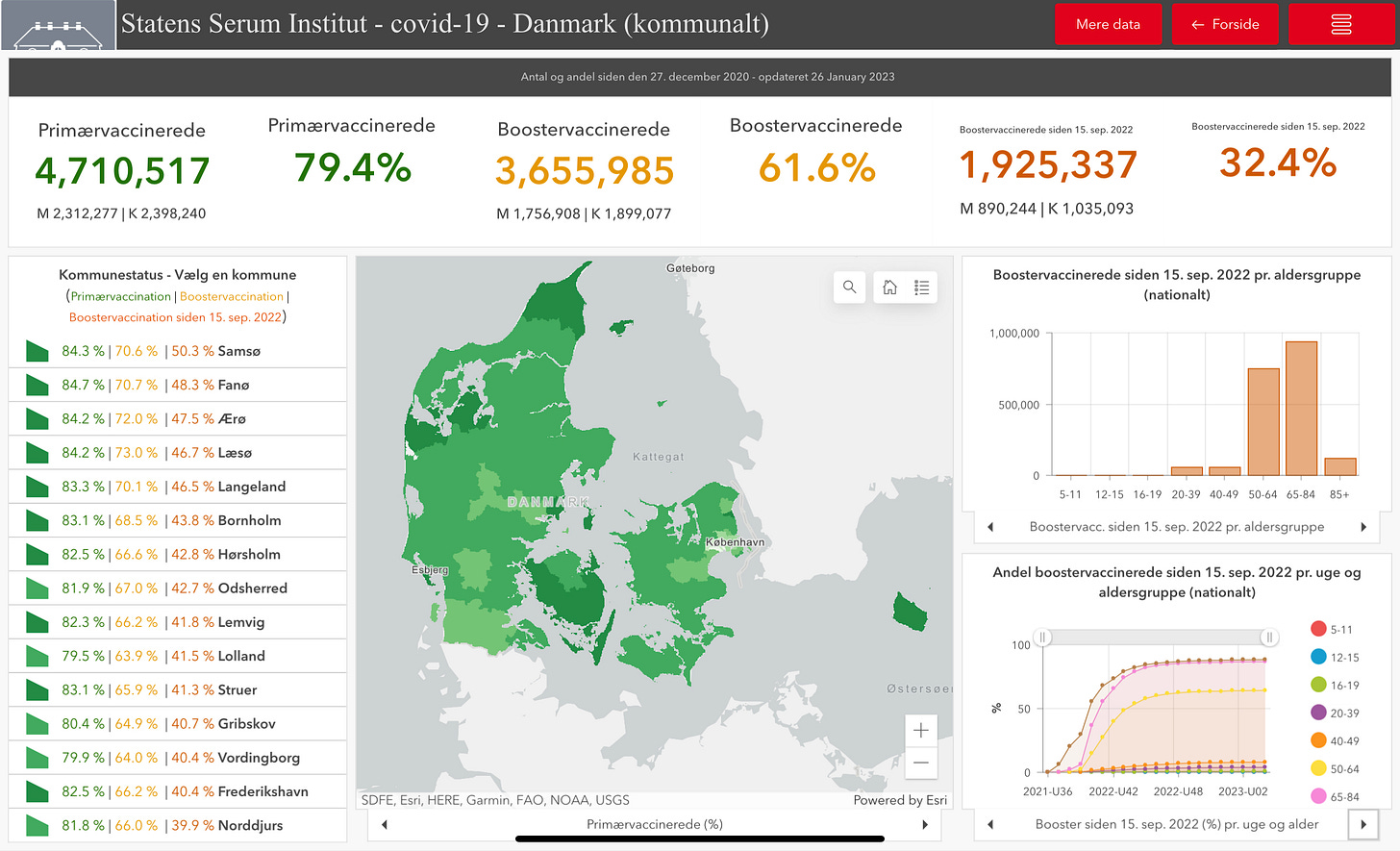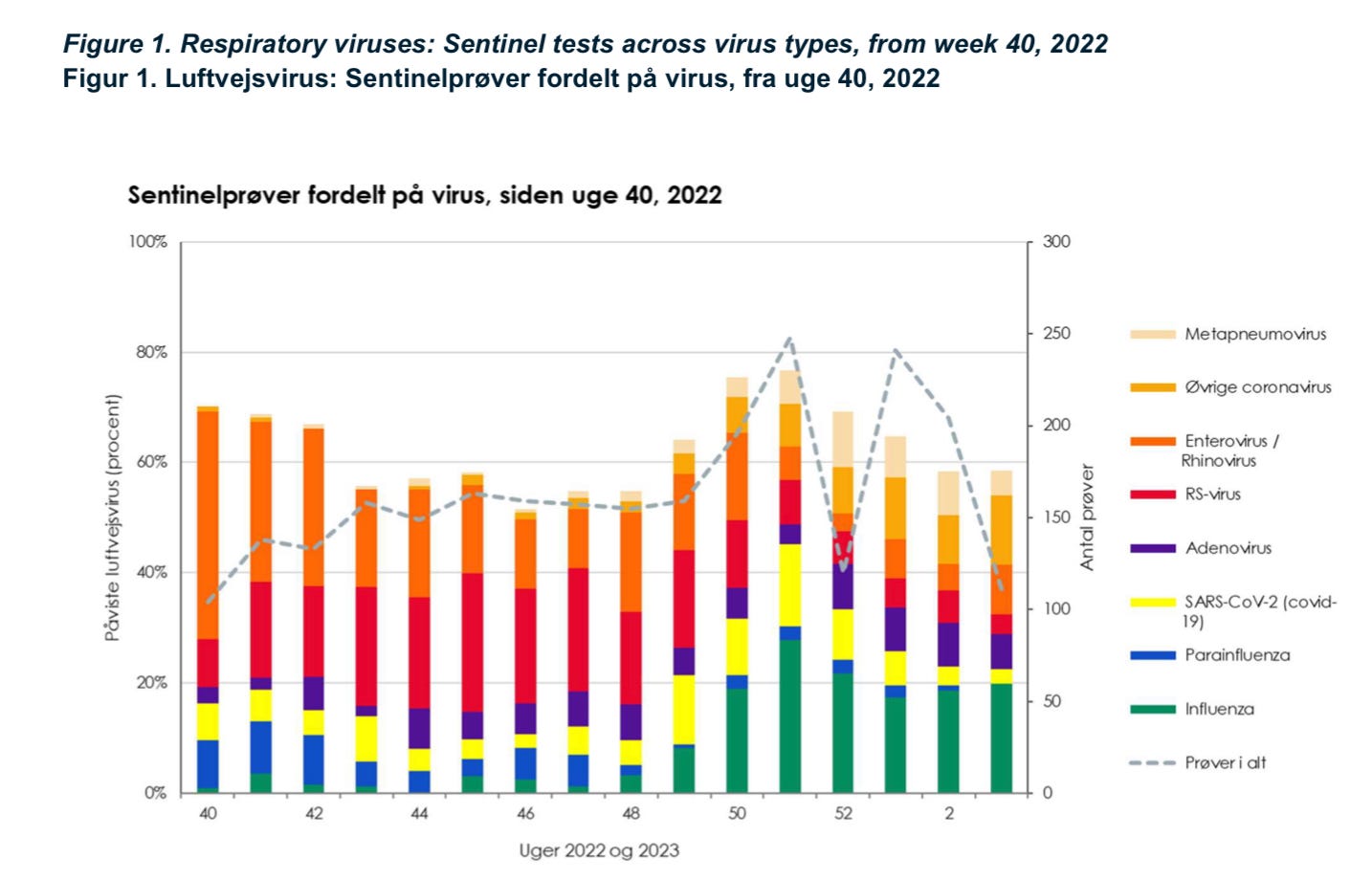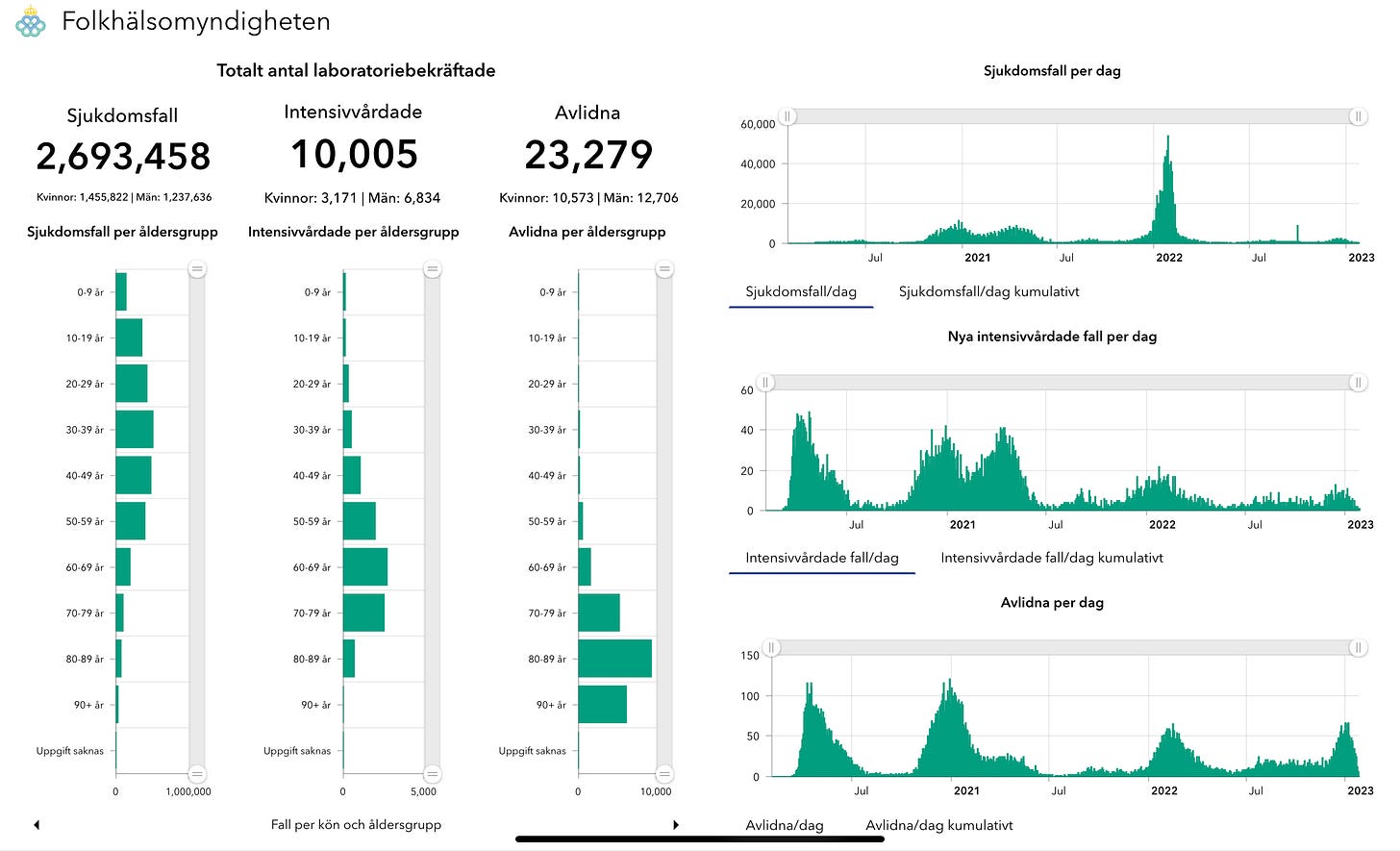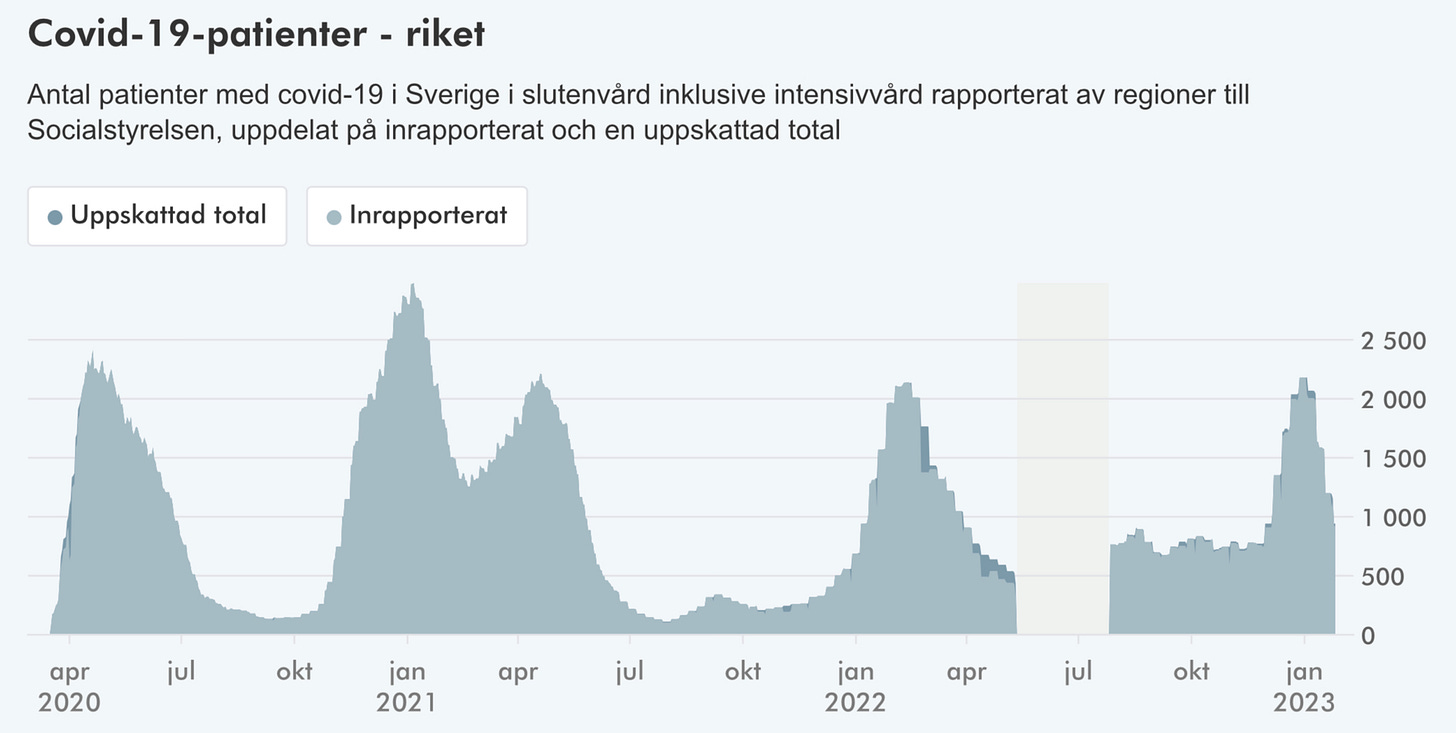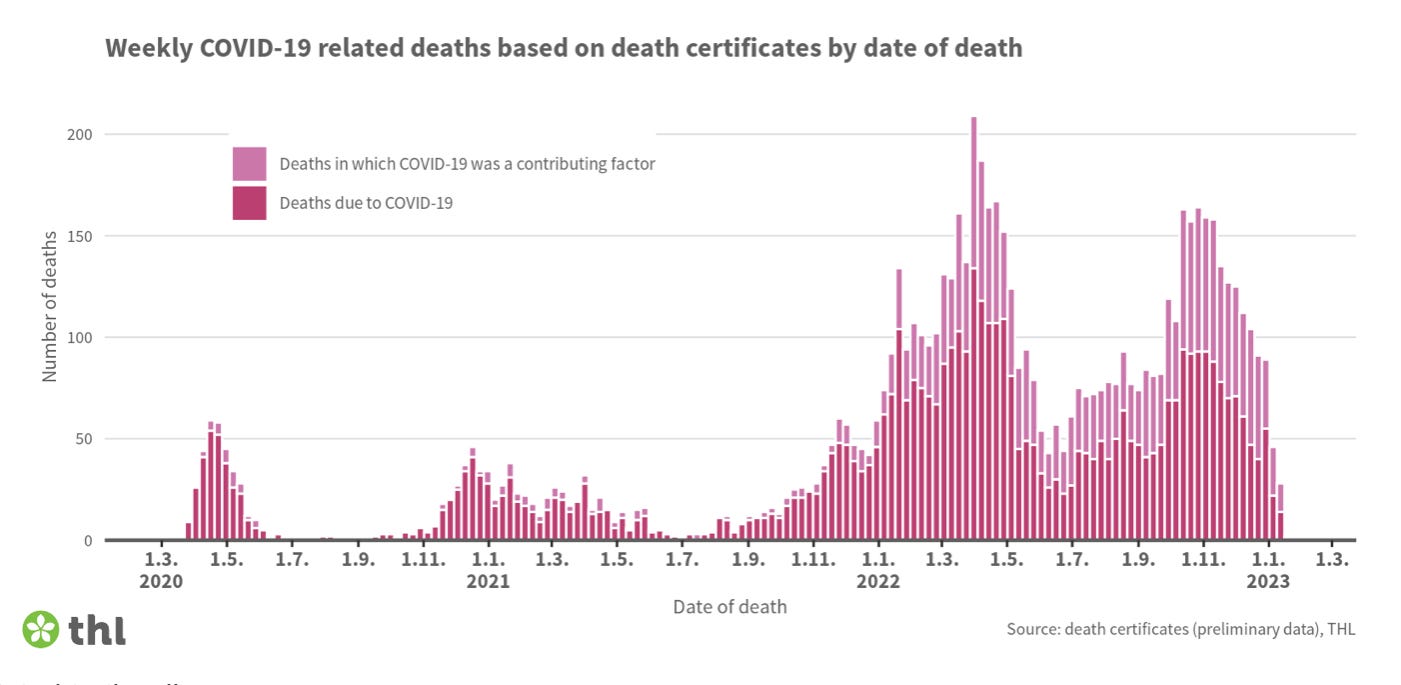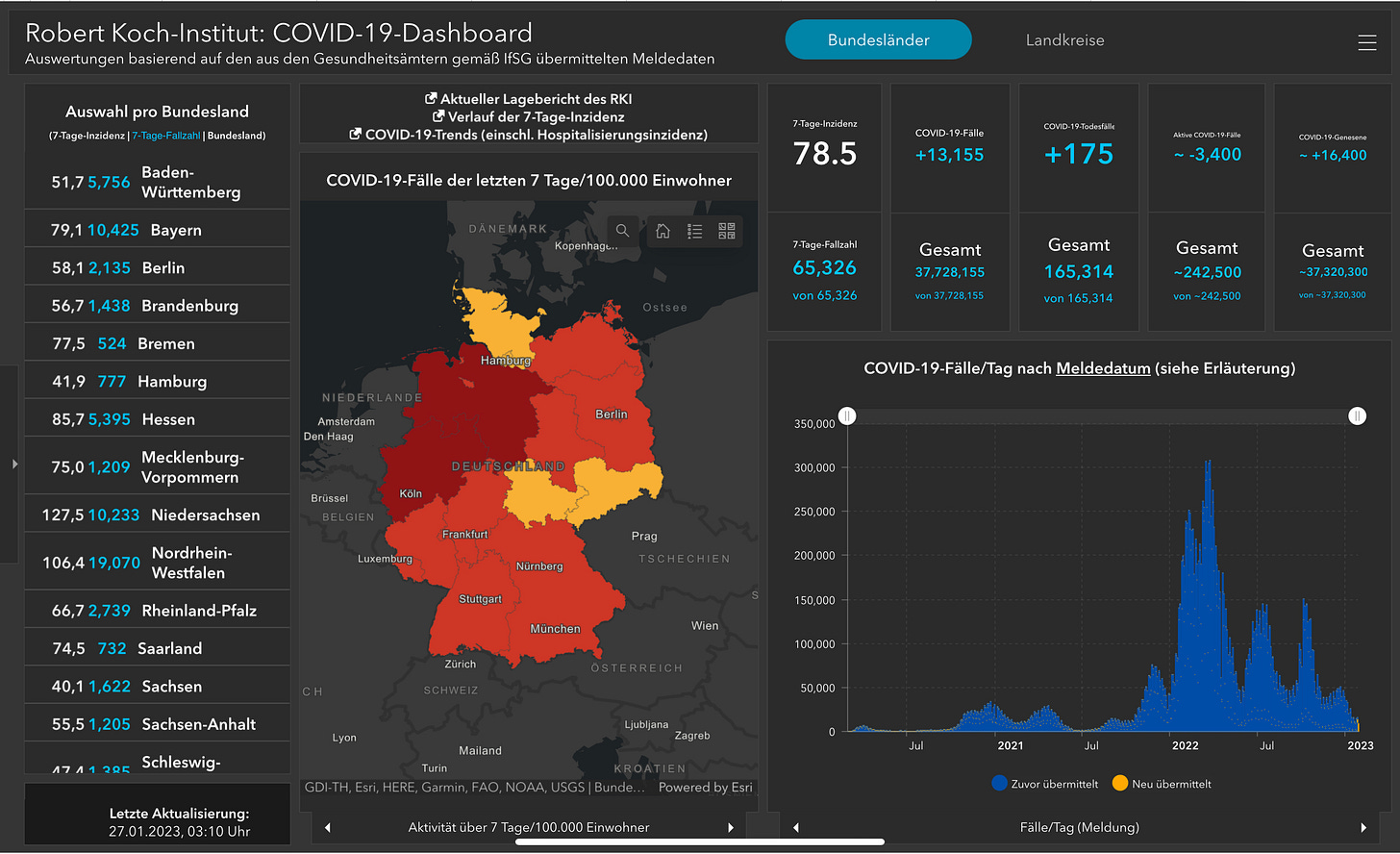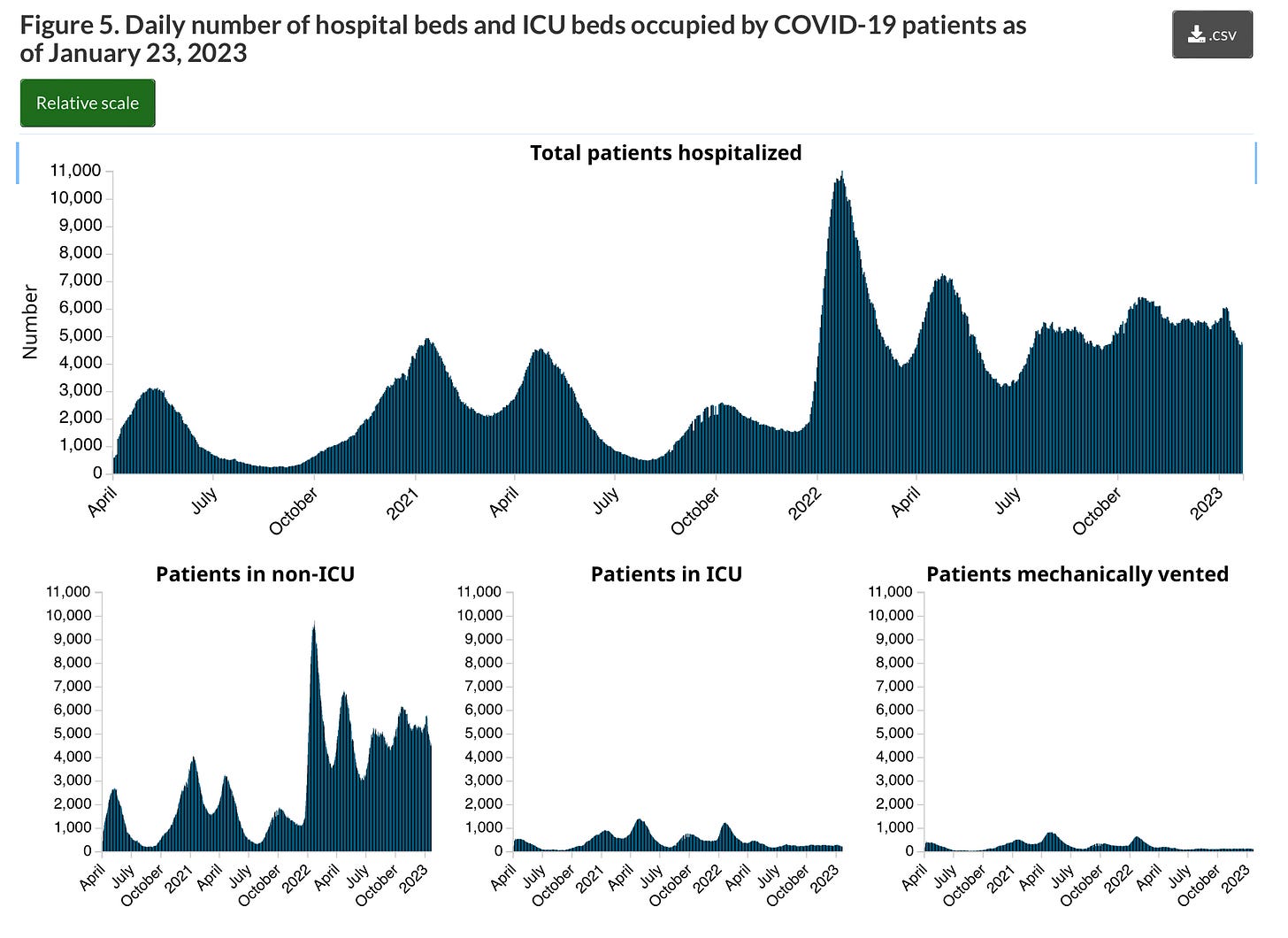*Editor’s note - Apologies this one is a little late. A stomach bug swept through our family this week and yesterday it was my turn.*
🦠Pandemic🦠
🇩🇰
The pandemic picture continues to show no sign of a holiday bounce as numbers, pretty much across the board, continue to drop. In its latest weekly pandemic assessment, the Statens Serum Institute says infection numbers and the COVID incidence rate per 100,000 people fell again last week. Both are unreliable statistics, especially as already incredibly low PCR testing numbers declined by another 24% from one week to the next.
It says the drop in corona cases was reflected across age groups. But, while overall infections were down, vulnerable seniors over the age of 80 continued to see the most infection activity. That said, the COVID incidence rate among elderly seniors has declined for a 4th week in a row going from 104 cases per 100,000 people down to 55.
The positivity percentage also dropped across all age groups. The highest rate, 9.5%, was seen among those 20 to 24 years old.
Denmark reported a super-low 186 COVID infections on Wednesday (underreported), including 79 reinfections.
With 2,539 PCR tests taken on Wednesday the positivity percentage is 7.32%. Over seven days the rate was 6.7%.
-
Hospitalizations continued to drop, with 227 new admissions last week, down from 382 the week before. As it has been for well over a year, 70 to 89 year-olds continue to make up the largest proportion of new admissions.
Looking at daily numbers, COVID hospitalizations (239) continue to tumble (-19) while the number of severely infected people in an ICU (19) inched down (-2) of those, the number on a ventilator (7) is unchanged day to day.
COVID admissions to a psychiatric facility (55) crept downward (-1).
-
Pandemic deaths remain too high in Denmark, but with 71 fatalities last week, there has been a slight decrease from the previous weeks 90 deaths. Day to day, there were six more coronavirus deaths.
The SSI warns that the overall mortality rate “remains significantly elevated, but it adds there are some signs over the last week it is beginning to decrease. The rate is most concerning among elderly seniors, especially those over the age of 85, where excess deaths are climbing steeply.
Oxford Professor of Virology and Immunology, and a former member of a pandemic committee advising the Danish government, Astrid Iversen, says a major reason for elderly seniors suffering soaring excess death rates is the COVID pandemic.
“We can remedy part of this by offering a BA.5 booster [dose] to the oldest now and focus on clean air. It didn't have to be this way and it doesn't have to continue.”
Iversen says first generation bivalent vaccines targeting the parent BA.1 Omicron strain were used on the oldest and most vulnerable when the fall booster dose campaign began. She says now they need to be inoculated again using the latest bivalent vaccine targeting the BA.4 and BA.5 variants.
“It is not only a question of excess mortality; it is also a question of serious illness, long-COVID, and reinfections. And the possible damage it causes to the immune system and so far unknown long-term effects.”
-
Confirmed infection cases among high-risk seniors in care have dropped for a 4th week in a row. But, so has PCR testing rates. There were 18 pandemic deaths among seniors in care last week, four fewer than the week prior. Hospitalizations among residents have also fallen.
-
Getting an accurate variant picture is getting harder and harder, as the Statens Serum Institute warns that with tumbling PCR testing numbers, the amount of genetic sequencing of positive results has also fallen. Tarim what it can tell, the institute says the BQ.1 variant is dominant, followed by the steadily growing BA.2.75 strain. The SSI notes a BA.2.75 sub-variant, CH.1.1 is also seeing increasing spread.
-
COVID wastewater surveillance, a more reliable statistic, continues to show falling week-to-week infection activity. In fact, the SSI says over the last three weeks national numbers have seen a sharp drop. The trend is also seen across all five Danish regions.
Sequencing of wastewater samples shows that BQ.1 makes up 56% of all virus activity. BA.5 numbers have remained stable. And XBB variants have declined slightly.
-
On the 2nd booster dose vaccination front, to date, 32.4% of the total population has a 4th dose.
Among the target group of those 50 years old and older the Statens Serum Institute says with a 2nd booster dose they are 71% better protected against a severe infection resulting in hospitalization than those with three doses
-
The Danish National Health Board is issuing new recommendations on the correct dosage of blood thinners to use on patients suffering from a coronavirus infection. It basically only recommends a high dose of blood thinners in the most severe cases. For example, a high dose is only recommended for adults, pregnant, and breastfeeding women with severe infections “who need preventive blood-thinning medication.” While for everyone else, it has been deemed safer to use a low dosage.
Chair of the Working Group Simon Tarp:
“During the COVID pandemic, there has been uncertainty about the optimal dosage of preventive blood-thinning medication for hospitalized patients with a coronavirus infection. On the one hand, blood thinning treatment reduces the risk of blood clots, but on the other hand, the risk of bleeding increases. Therefore, we have reviewed the existing clinical trials to assess the correct dosage.”
-
The Statens Serum Institute’s sentinel monitoring system shows that the most common respiratory virus detected two weeks ago was influenza. It says this is a trend that is “tentatively” expected to continue into week three. That said, the overall proportion of respiratory virus activity has declined in the first two weeks of the year.
Cases and related hospitalizations have called for both the RS virus and influenza A over the past week. But, influenza B-related infections and hospitalizations remain at a “stable level.”
🇸🇪
Sweden has added 2,985 new infections (wildly underreported) and suffered another 259 corona deaths in the last week.
COVID hospitalizations (921) have plummeted (-652).
Vaccination stats haven’t been updated this week.
-
Travel restrictions requiring travelers from China to have a negative COVID test will expire tomorrow (Saturday). But, the Swedish Public Health Agency is asking the government to extend the test mandate.
Director General Karin Tegmark Wisell:
“Although there has been some information about the epidemiological situation and development in China, both the WHO and ECDC assess that the situation remains uncertain. The Public Health Authority therefore believes that the government, in accordance with current recommendations from ECDC, should consider extending the temporary requirements for a negative test for a short period.”
Sweden introduced the test mandate for all travelers arriving from China on January 7, as coronavirus cases exploded in China.
🇳🇴
After being buffeted by COVID, influenza, and RS virus infection waves, Norway appears to be coming out the other side. The Norwegian Institute of Public Health says the COVID wave “is coming to an end” as it sees large drops in confirmed cases and hospitalizations over the last few weeks. Although it cautions “a new wave may come later this winter.”
“Preparedness in hospitals and municipalities must be maintained this winter in view of the continued high incidence of disease, high levels of sick leave, many admissions, and many outbreaks in nursing homes and hospitals.”
COVID wastewater surveillance, which only covers about 30% of the Norwegian population, also shows a “sharp decline” in virus activity. The number of pandemic-related hospitalizations fell from 116 to 63 from one week to the next. The number of severely infected people needing intensive care is also down, with just nine patients last week, two fewer than the week before. The NIPH says coronavirus-related visits to a family doctor or an emergency room have also dropped. The number of COVID deaths also declined in Norway last week, falling by almost half with 53 fatalities compared to 104 the week previous.
The BQ.1.1 variant remains dominant in Norway, but BA.2.75 numbers are increasing as are recombinant strains like XBB and CH.
The NIPH says influenza numbers have also dropped like a rock so far this month. But the health agency noted the declines showed signs of leveling off last week due to an increase in influenza B infections. Influenza-related hospitalizations declined sharply last week. There were 213 flu-related admissions last week, a drop from the previous weeks 312. Intensive care numbers rose slightly from five to eight. The influenza positivity percentage dropped from 25% in the last week of December to 13% last week. Flu-related visits to a family doctor have also decreased.
Flu vaccination numbers in Norway remain unimpressive. 63% of seniors over the age of 65 have a flu shot. Coverage is just 34% among those 18 to 64 who are in high risk groups. A mere 7.3% of children have been vaccinated against influenza. Vaccination coverage among healthcare workers is just 38%.
The one remaining concern is the RS virus. The health institute says infection numbers “picked up somewhat” last week and it added “further developments are uncertain.” RS virus-related hospitalizations also increased, going from 167 admissions to 195 from week to week. The majority of hospitalizations continue to be children under the age of five. The positivity percentage among children is a whopping 43%, up from 40.2% the week before.
🇫🇮
Finland has registered 8,790 new infections and three more virus deaths in the last week.
-
Finland suffered the highest number of deaths in 2022, “since the war years.” Statistics Finland says the country recorded 62,886 deaths last year, an increase of more than 5,000 fatalities from 2021.
Life expectancy in Finland also dropped by about half a year. Life expectancy for boys born last year is 78.6 years, and 83.8 years for girls. Statistics Finland says the last time life expectancy dropped by this much was in 1957, due to the Asian flu pandemic.
The agency says the birth rate in Finland was the lowest in 150 years, or basically since the statistics first began to be measured. 44,933 children were born in Finland last year, which is 4,661 fewer children than the year before.
It is interesting to note, that Finland was entirely reliant on immigration for population growth last year. There were 17,278 more people in Finland year over year, which was sustained by having 34,789 more arriving immigrants than those who left the country. Statistics Finland says 2022 immigration statistics do not include the number of Ukrainians who fled the war and were granted temporary protection status in Finland.
🇩🇪
Germany recorded 13,807 infections and 138 more pandemic deaths in its Thursday daily report.
It added 1,090 new hospitalizations while ICU numbers (672) inched upward (+5). As a percentage of all intensive care beds in the country, pandemic patients were using 3.1%.
🇪🇸 🇩🇪 🇦🇹 🇬🇷
Spain is ending one of its last COVID restrictions. Effective February 7, masks will no longer be required on all public transportation. However, masks are still required for anyone going into a hospital or health clinic.
Spain, Germany, Greece, and Austria were the only European countries to still require masks on public transportation. But the mandate is due to expire on January 30, in Greece. Effective February 2, Germany is lifting its mask mandate on all long distance national train routes. In Austria, masks are only required on public transport in the city of Vienna.
🇨🇦
COVID hospitalizations have declined across Canada. The total number of hospital beds used by an infected patient declined from 5,115 to 4,701 in the week ending January 23. Of those, general admissions dropped by 372, to 4,502. Intensive care beds in use also declined to 199, 42 fewer than the week before. While the number of severely infected people on a ventilator fell to 89, a drop of 17 week to week.
-
“Misinformation is an urgent societal concern that affects us all.”
COVID misinformation has resulted in thousands of deaths and unnecessary hospitalizations, according to a new report. The Council of Canadian Academies found that coronavirus conspiracy theories and vaccine misinformation resulted in at least 2,800 unnecessary deaths and thousands of hospitalizations that didn’t need to happen. The authors of the report note these are conservative estimates because the numbers didn’t capture ripple impacts like postponed surgeries, long-COVID treatment, and the cost born by healthcare workers on the front lines.
The report found that over just a nine-month period in 2021 pandemic misinformation and vaccine conspiracy theories swayed an estimated 2.4 million people from getting vaccinated. It says had those people made the more informed choice to protect themselves, it would have directly resulted in about 200,000 fewer infections and 13,000 less hospitalizations.
⚡️Energy Crisis⚡️
🇩🇰
Danish energy companies have to pay back a big chunk of the money they made in record profits due to soaring energy prices. In all, it will equal a 1.2 billion Danish kroner bite out of their profit margins.
Tax Minister Jeppe Bruus spoke to DR:
“Overall, in 2023 there will be proceeds of DKK 1.2 billion (about $234 million Cdn). We will return that money to consumers in connection with the forthcoming negotiations on inflation aid.”
The Ministry of Taxation is expecting that fossil energy companies alone will be sending 800 million Danish kroner (about $154 million Cdn) into the treasury.
-
People in Denmark seem to have taken the energy crisis to heart. The Danish Energy Agency says that electricity use in the second half of last year fell by 6% while natural gas consumption dropped by 19%.
Deputy Director of the Danish Energy Agency Martin Hansen:
“The energy supply is currently stable across all energy sources, and we continue to assess that it will not be necessary to interrupt electricity and gas supply to consumers this winter. We must stick to good habits so that we don't get into trouble.”
🇺🇦/ 🇷🇺 War
🇩🇪/ 🇺🇦
Germany has finally come off the fence, but in an underwhelming way. The German government has announced it will send 14 Leopard 2 tanks to Ukraine. Reports say the country has more than 200 of the tanks in storage.
German Chancellor Olaf Scholz, in making the announcement, added that even though it was donating the tanks to Ukraine, that Germany will ensure that NATO countries are not drawn into a direct conflict with Russia.
German Defense Minister Boris Pistorius says the Leopard tanks his country will donate to Ukraine will arrive at the “end of March, beginning of April.” Ukrainian soldiers will also have to be trained on how to use the tanks.
“And for the Ukrainian soldiers who are to be trained for the Leopard tank, it will happen a little later.”
🇸🇪/ 🇺🇦
Sweden has also indicated it will contribute tanks to Ukraine.
Swedish Defense Minister Pål Jonson says possibly by today (Friday) Sweden will participate in an international working group to coordinate the donation of tanks to Ukraine.
“I will also give the Armed Forces and FMV an instruction to support the government in that work. Ukraine needs tanks, but also combat vehicles and qualified artillery to strengthen its ground combat capability and be able to push Russia back.”
As for what Sweden might actually contribute, Jonson would only say Sweden will join other countries in sending tanks to Ukraine.
“The contribution must be realistic and have an effect on the battlefield. Then the Armed Forces' assessment and good international coordination are needed. We must now take a serious look at exactly what a Swedish contribution might look like. I am not ruling anything out and we are also looking at whether it is possible to contribute with training, maintenance and logistics.”
He says Sweden is currently still facilitating the transfer of CV90 combat vehicles and Archer artillery systems that it announced it would give to Ukraine last week.
🇳🇴/ 🇺🇦
Norway is joining an international coalition in sending more modern tanks to Ukraine. But, the Norwegian Defense Ministry isn’t saying exactly how many tanks, or even what type, will be shipped to Ukraine. The Norwegian military has its own version og the German-made Leopard tank.
Defense Minister Bjørn Arild Gram says the tanks will come with spare parts, training, and other logistical support.
“It is important that allies and partners coordinate closely so that the help in sum is as useful as possible for Ukraine. We are weighing and considering our own needs and preparedness. At this time it is the right thing to do to take some of our own equipment in order to support Ukraine. It is important for Norwegian security that Russia’s aggression against Ukraine does not continue. The situation affects Norwegian and European security too.”
Norway’s Defense Ministry says it is also putting plans together for a larger military contribution to Ukraine that will span several years.
-
Norway’s Armed Forces will provide specialized military training for Ukrainian troops. The training will be coordinated through the ‘Operation Interflex’ international effort by the United Kingdom, even though the training itself will take place in Norway. Ukrainian soldiers will receive training as medical specialists, junior officers, as well as sniper training from Norwegian soldiers.
Defense Minister Bjørn Arild Gram says to fulfill its training obligations the number of Norwegian instructors will be increased.
“The training will complement other training initiatives. Our contribution will strengthen the overall training effort and is welcomed by both Ukraine and our allies. This training will quickly strengthen the capabilities of Ukrainian soldiers and increase the total number of soldiers western countries can train. Ukraine needs more and better-trained soldiers to fight Russian invasion forces. In addition, they need to increase their competence in several professional fields. It is important that Norway contributes with training and shares the burden with our allies.”
The plan is to start the new training programs this spring and conduct several rounds throughout the year.
🇫🇮 🇺🇦
Finland’s Defense Minister called a Wednesday press conference to say his country will participate in the effort to get more modern tanks to Ukraine. But, interim Minister Mikko Savola was very short on details. He says Finland’s contribution will be “limited” and that no final decisions have been made yet.
Davila wouldn’t speculate on how many tanks might be involved, or when they would make their way to Ukraine. To be fair, Finland has kept its military donations to Ukraine largely under a veil of secrecy.
🇬🇧/ 🇺🇦
British has already announced it will send a contingent of its Challenger 2 tanks to Ukraine. British Defense Minister Alex Chalk says the 14 tanks will arrive in Ukraine by the end of March.
🇺🇸/ 🇺🇦
It is official, on Wednesday, United States President Joe Biden announced that the U.S. would donate 31 M1 Abrams tanks to Ukraine. Biden says a training program will begin immediately to get Ukrainian troops up to speed on the tanks operations.
“The tanks are complex to operate and maintain. That is why Ukraine is also getting spare parts and equipment to keep these tanks running on the battlefield.”
🌎/ 🇺🇦
With an international coalition working together to supply Ukraine with more modern tanks, conversations are now turning from fighting on the ground to battling in the air. The Chief Operating Officer for Lockheed Martin has told the Financial Times there is “a lot of conversation about third party transfers of F-16s” and the company is “going to be ramping production on F-16s to.” It wants to ensure that it can backfill any country that chooses to do a third party transfer to get the fighter jets to the Ukrainians.
Advisor to the Ukrainian Defense Minister Jurij Sak told Reuters that his country desperately wants to upgrade its Air Force, which currently consists of old Soviet era fighter jets more than 30 years old.
“The next big challenge will now be to get fighter planes. If we get them [Western fighter jets], then the benefits on the battlefield will be enormous. Fourth-generation aircraft like the F-16, that's what we want.”
A number of European and North American countries are either already phasing out F-16s or planning to or planning to do so shortly as they transition to new F-35s.
🇳🇱/ 🇷🇺
The troubles facing Russia continue to mount. The European Court of Human Rights has given the Netherlands the authority to launch a court trial against Russia for the shooting down of Malaysian Airlines flight MH17 in 2014. The plane was shot down over Eastern Ukraine with 298 people losing their lives.
The decision from the court ruled that even though the tragedy took place over Ukraine, the area was controlled by Russia at the time.
“The court finds that areas in eastern Ukraine under the control of the separatists from May 11, 2014, to at least January 26, 2022 were under Russia's jurisdiction.”
Previous evidence has also linked Russia directly to the shooting down of the airliner. A Dutch court has already convicted two Russians and a Ukrainian for the terror attack. All three were convicted in absentia. All three are believed to be in Russia, which has refused to extradite them.




